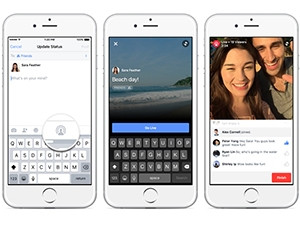
Some South African iPhone users will notice a 'Live' icon is available when updating their status on the Facebook smartphone app today.
The social networking giant has started rolling out its live-broadcasting feature in South Africa on iOS. It will start with 10-25% of users and is expected to scale up to 100% in the following weeks.
The feature was launched in August last year, originally only for public figures and celebrities, through its Mentions app. It was then expanded to all users in the US in December.
The term 'live-broadcasting' refers to a mobile user live-streaming themselves over video to a private or public audience. Last year, numerous apps dedicated to live-broadcasting were launched - highlighting a changing trend in how audiences are consuming news: instantaneously and in real-time. Live-broadcasts provide the viewer with a first person view of the person or event.
"To share live video, tap on Update Status and then select the Live Video icon. You can write a quick description and choose the audience that you want to share with before going live," explained Facebook product manager Vadim Lavrusik in a blog post.
"During your broadcast, you'll see the number of live viewers, the names of friends who are tuning in, and a real-time stream of comments. When you end your broadcast, it will be saved on your Timeline like any other video, which you can then delete or keep for your friends to watch later."
Facebook says it is working on the feature to Android users. However, anyone - on an iPhone, an Android device or the Web - can view the live broadcasts.
Slice of the Twitter pie
After rival Twitter's dismal earnings results last week, local analysts said the micro-blogging site should focus on what it knows best - live reporting, with emphasis on its live-broadcasting app, Periscope.
Periscope was launched early last year and within four months, it had over 10 million accounts on the platform. At the beginning of August 2015, 40 years' worth of video was being watched each day.
However, Facebook has 1.59 billion people now using the social network each month and 90% of users do so via mobile devices.
"There is no question that people are more comfortable using Facebook as a multimedia consumption platform," says World Wide Worx MD Arthur Goldstuck, who has always found Periscope to be a curious option.
"Twitter is not very good at getting buy-in from new users. People pop-in to the service, they do not sit there scrolling through media like they do on Facebook."
Goldstuck says consumers are ready for the live-broadcasting service on Facebook; it will be media outlets that will have to figure out how to use it correctly.
"Live-broadcasting will certainly add to the richness of the Facebook experience. The term 'rich' is key here as it describes the Facebook media environment. Twitter, on the other hand, is a micro-media environment. These environments determine how people enter the platform.
"Twitter needs to change people's perspective on what it can do and this will require massive strategic thinking."
Goldstuck says Facebook is defined by its extensive innovation across all fronts: "It is always testing new products and can quickly tell what works and what does not."
Twitter can't compete, says Goldstuck, because it is not operating at that level.
Instant articles for all
Facebook also announced today it would open its Instant Articles option to all publishers at its F8 Conference in April.
"We will be opening up the Instant Articles program to all publishers - of any size, anywhere in the world," said Facebook's Josh Roberts in a blog post.
The feature was launched last year in May, at first as an experiment with limited media outlets, to publish articles directly in Facebook's News Feed - eliminating the need for users to leave the app.
Publishers in the initial rollout included the New York Times, National Geographic, BuzzFeed, NBC, and The Atlantic.
"We built Instant Articles to solve a specific problem - slow loading times on the mobile Web created a problematic experience for people reading news on their phones," explained Roberts. "This is a problem that impacts publishers of all sizes, especially those with audiences where low connectivity is an issue."
Roberts says publishers have full control over the look of their stories, as well as data and ads. There is the option to sell their own adverts and keep 100% of the revenue, or let Facebook help out and the social network will keep a 30% share of profits.
Share